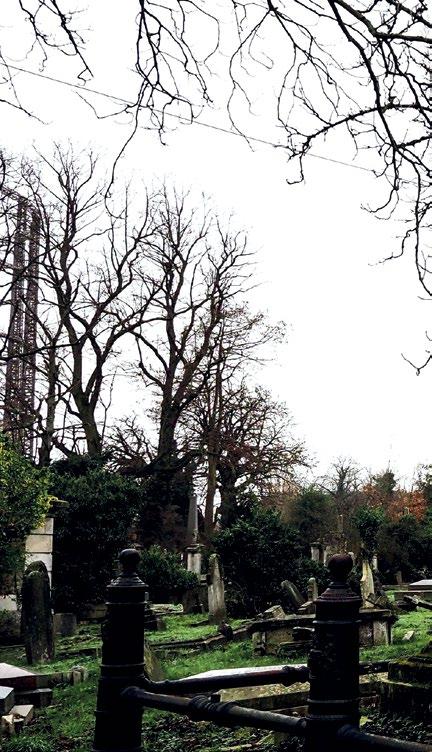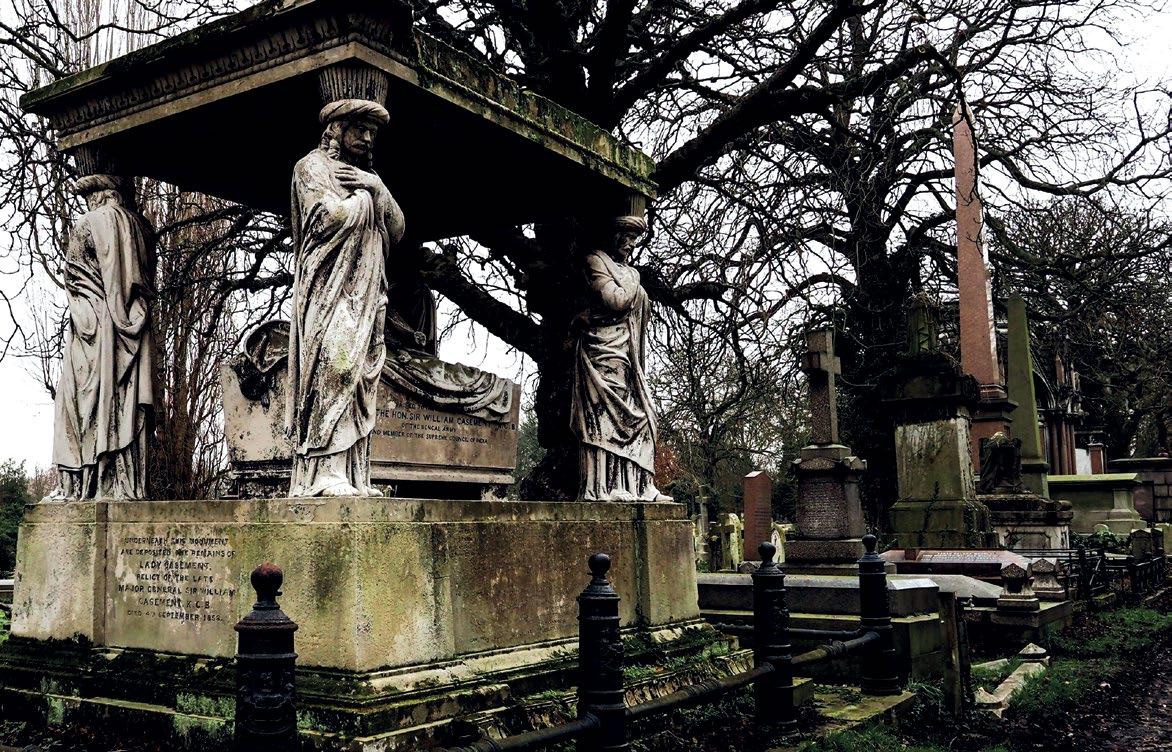
6 minute read
Overlooked Britain: Kensal Green Cemetery Lucinda
Overlooked Britain Paradise, by way of Kensal Green
lucinda lambton London’s first great necropolis hosts a perpetual party of 19th-century luminaries
Advertisement
Nothing could be more enlivening than a walk round Kensal Green Cemetery in London, the capital’s first great necropolis, founded in 1832.
Whatever your passion, with all those who are buried here, the inventors, writers, entertainers etc – every one of them of them of top-notch interest – the very essence of their roots and shoots can be joyfully relished within these walls.
Surrounded by the scrunching cityscape of the Harrow Road, it suddenly appears; a vast tract of Arcadia, a place that makes your spirits soar to screaming delight.
Trollope lies here, as does Sir Charles Locock, who delivered all Queen Victoria’s children. Blondin the tightrope-walker is buried at Kensal Green; so too is WH Smith – with a marble book atop his grave. Charles and Fanny Kemble, father and daughter thespian stars, are here, as well as John Smith, harpist to Queen Victoria!
Greeting you, among the bulgingly mature chestnut, ash, plane, holly and beech, is a Gothic spire to Feargus O’Connor (1794-1855), the charismatic Chartist leader. He died insane, and crowds of 50,000 came to his funeral at Kensal Green.
Here is a Gothic canopy, sheltering the remains of George Augustus Frederick Percy Sydney Smythe, 7th Viscount Strangford (1818-57). He was believed to be the last man to have fought a duel in England, when in 1852 he exchanged shots with his political rival in Canterbury. Described by Disraeli as ‘a man of brilliant gifts, of dazzling wit, of infinite culture, and of fascinating manners’, he was the model for the hero of Coningsby. He died aged 40, worn out by dissipation, brandy and water, and a delicate chest. ‘Poor George,’ lamented Lord Lyttelton at the time; ‘he was a splendid failure.’
Your next goal is the stone slab surrounded by railings, to William Makepeace Thackeray (1811-63), author of Vanity Fair, The Luck of Barry Lyndon etc. Dwell for a moment on his funeral, which took place here in 1863. Dickens was one of the chief mourners, as were the painters Millais and Frith. George Cruickshank the caricaturist was also there, as were Browning and Trollope.
According to a contemporary account, there were occasional melancholy interruptions of weeping but ‘more obtrusive were the cracks of sportsmen’s rifles from the neighbouring fields, causing the horses to champ their bits in noisy restlessness’. It must have been a mighty coffin as Thackeray was over six feet three inches tall and his vast head housed a brain weighing 58½ ounces.
With the path becoming ever more rural in its roughness and the trees ever more enveloping, you turn right onto an even tinier, grass path. There you find a block of marble to Isambard Kingdom Brunel (1806-1859), along with his father, Sir Marc Isambard Brunel (1769-1849). Brunel senior designed the Thames Tunnel, while his son was responsible for the triumphant design of bridges, steamships and railways. The Great Western, passing hard by the cemetery, is in thundering earshot of his final resting place.
Your next stop should be the newly restored four-poster-bed-like canopy sheltering the remains of William Mulready RA (1786-1863). With his face carved from his death mask, he lies on a wonderfully ‘woven’ stone mat of straw, on a fringed bier, beneath which are carved scenes and implements of the artist’s life. The son of an Irish leatherbreeches-maker, he was to design the first one-penny prepaid envelope, as well as becoming an artist and prolific illustrator.
Now for a quite tremendous treat – the Egyptian mausoleum to Andrew Ducrow (1793-1842), a showman of dazzling appearance and ability, who, while dressed as a Roman statue, would ride or drive as many as nine horses at once. He was famed too for ‘poses plastique équestre’; striking attitudes as Zephyr, Mercury or a Yorkshire fox hunter, while controlling horses at the gallop.
He died in 1842, a few days after his favourite horse, John Lump. His hat and gloves – of stone – lie at the door of his extravagant mausoleum.
Here you might sense a most magical magnet beneath your feet, drawing you downward to those who lie in the catacombs below. Think, for example, of George Polgreen Bridgetower, a violinist to whom Beethoven dedicated the Kreutzer Sonata. Then there is Sir William Beatty, Nelson’s surgeon at Trafalgar, who lies a stone’s throw from Thomas Wakley, the medical reformer who founded the Lancet. Augusta Leigh – Bryon’s half-sister – lies nearby.
There they all are, in rotting coffins, studded with gilt-headed nails, stilts and yet again with his manager on his back. That same poor fellow was then pushed across in a wheelbarrow. Blondin’s final flourish was to stop halfway along this perilous progress, set down a stove and cook and eat an omelette!
Next left and along on your right is the pink granite tomb of Anthony Trollope (1815-82). Having left school barely being able to write, he became a clerk at the post office, where he worked in tandem with writing for the rest of his life. Here lies the man who, as well as Barry was in fact a woman, who spent her entire life as a man in the army. She entered as a hospital assistant and rose through the ranks, becoming a surgeon – with all pre-anaesthetic horrors – and rising as high as Inspector General.
Lord Albermarle described Barry as ‘the most wayward of men; in appearance a beardless lad … there was a certain effeminacy about his manner which he was always striving to overcome. His style of conversation was greatly superior to that one usually heard at the mess table in those days.’

resplendent with red, purple and brown velvet. Row upon row of fancifully formed plaques, their rust glistening like jewels, reveal the names of every occupant.
Above ground again and on down Centre Avenue. Turn first right onto a grassy path and go 18 plots down on the left, where you find a cross to Wilkie Collins (1824-89), author of The Woman in White, The Moon Stone, as well as No Name and Armadale, to name but four of his miraculously mysterious creations. He is buried with his mistress – the inspiration for The Woman in White.
Return to the main path and you see the memorial to Blondin the tightropewalker. Charles Blondin (1824-97) walked over the Niagara Falls on his 1,000-foot-long rope in 1859. He was then to walk it blindfold, then on becoming a writer of renown, invented the letter box.
A tiny and tempting detour is to walk 22 plots to the south. where you’ll see the gabled stone over the body (although not the head, which is in Lincoln’s Inn Fields) of Charles Babbage (1791-1871), who in 1812 first thought of ‘calculating numerical tables by machinery’. Between 1820 and 1822, he devised his ‘analytical engine’ – with perforated cards – and so invented the computer.
To discover a ‘first’ in any field is exhilarating enough; here in Kensal Green there are almost as many as there are blades of grass!
Next head for the quite ordinary headstone honouring Dr James Barry (1795-1865), concealing the most extraordinary life of all. For ‘James’
Remarkably, Barry was often accused of breaches of discipline. ‘He’ had a quarrelsome temper and even fought a duel when stationed at the Cape. It was said that the servant who waited on ‘him’ for years had not the slightest suspicion of ‘his’ gender.
Look back at this cemetery from afar, at the great swathe of countryside cutting through the chimneys – by day, green; by night, jet-black – and ponder on the people who lie within its walls.
I have never been in any doubt that there is a perpetual party going on – a glorious and glittering party of 19thcentury luminaries. If there is life after death, you could find no more vibrant a collection of characters than those gathered together at Kensal Green.










